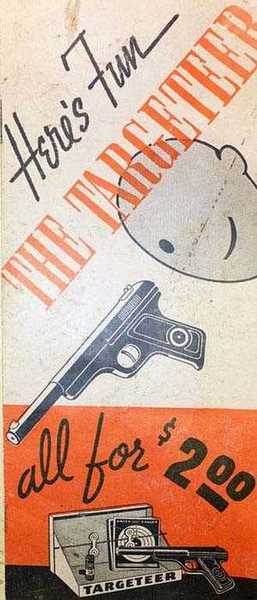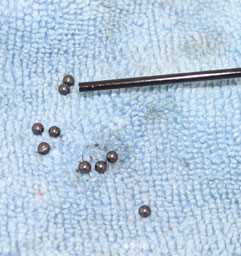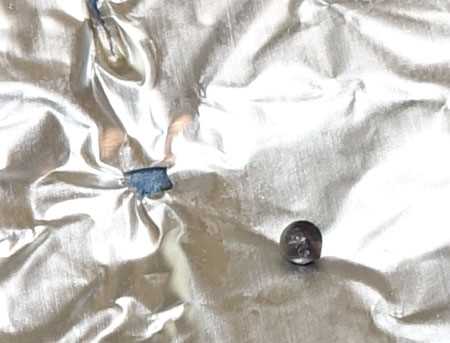by Tom Gaylord
Writing as B.B. Pelletier
This report covers:
- Maintenance
- Success!
- Lead shot is not consistent
- Sorting shot
- Loading technique
- BB rollout
- Velocity
- Accuracy testing
- Cocking effort
- Trigger pull
- Summary
Maintenence
The last time I looked at the Targeteer I lubricated it with a lot of Crosman Pellgunoil. How many drops, you ask? Maybe 50. It’s still oily a week later, which a BB gun needs to be, to work its best.

I just thought you would like to see the cover of the manual.
Success!
And they all said — whaaaat?
A couple readers knew I was having problems getting either of my two Daisy Targeteer pistols to shoot. I was working on the problem, but last week I was stumped. Fortunately this ain’t my first rodeo and I finally remembered what I used to do.
Lead shot is not consistent
We know that lead birdshot is not of consistent size, regardless of how it is made. That had to be the problem. When I looked through the barrel I saw nothing. There should have been light shining through, so the barrel was plugged. I found something to ram through the barrel — turned out to be one of those thin plastic spray tubes that come with many aerosol cans. Remember — this Targeteer is .12 caliber, not .177!
When I pushed the stick through the bore I found a jam in the middle of the bore. Four lead shot poured out and the one in front was the big one. The others fit fine, but with the one blocking the way they couldn’t move.
Sorting shot
Most number 6 birdshot is small in the Targeteer bore. But the ones that are too big will stop the show every time. So you need to sort the shot before shooting.
Remove the shot tube and drop each shot through the muzzle. It should drop out of the breech on its own. I put a cloth with a thick nap behind the breech to catch each shot as it fell through. The nap keeps it from rolling. Doing this I found about one shot in 10 was too large for the bore. Those you get rid of; the others can be shot.

These shot have been sorted for size. There is the end of the spray straw I use for ramming.
Loading technique
The most effective way to load a Targeteer is to cock the pistol, then drop a shot down the muzzle with the muzzle pointed straight up. I like to ram the shot after that with the spray tube. Ramming pushes the shot into the breech where it is held until the shot. I will explain.
The reason you cock before loading is to retract the pusher air tube on the end of the piston. You may recall that a BB gun uses both a catapult push on the BB by means of this tube, which also contains the air transfer port. Then the compressed air rushes through the tube to boost the velocity. If the gun just used the spring force to catapult the shot, the velocity would be around 50 f.p.s. It is that air boost that gives the BB gun its velocity.
If you loaded the shot and then cocked the gun, the air tube on the end of the piston might retract, leaving the shot in the bore where it was, until the air blast hit it. The velocity would suffer. There is also a second reason to ram each shot.
BB rollout
When a BB gun is cocked, why doesn’t the BB just roll out the barrel when the muzzle is pointed down? The reason is because there is a spring in the breech of the shot tube that holds the BB in place until the air tube on the piston pushes it past this barrier and down the bore. If you ram the BB into the Targeteer barrel it will engage this spring and remain in the breech. If you don’t, it will roll out when the muzzle is depressed. I tried this several times both ways to prove it.
Velocity
The small caliber of the Targeteer made recording the velocity tough. I told you that would be the case. But I did manage to record the velocity for one of each type of shot — the number 6 lead birdshot and the Daisy steel BB. The birdshot went out at 106 f.p.s. and the Daisy BB went out at 119 f.p.s. Obviously this ain’t no magnum!
Accuracy testing
That will make testing accuracy difficult, as well, because the Targeteer shot bounces off a paper target. But it does go through Post-It note paper at close range. That gave me an idea! What would it do to aluminum foil? So, I tried it.

The slow Targeteer shot tears through aluminum foil well enough.
As you can see, the shot passes through the foil readily. If I construct a target of aluminum foil I should be able to get a pretty good idea of the gun’s accuracy. I may even try it with some vintage .12-caliber Daisy Steel BBs, as well as lead shot.
Cocking effort
The pistol cocks with 15 pounds of effort. I am sorry but the slide is too slippery for me to pull back — I have to push the muzzle in with the heel of my hand.
Trigger pull
The single-stage trigger breaks at a consistent 3 lbs. 6 oz. The blade is very thin so I’m glad it isn’t any harder than this.
Summary
So far the Targeteer has proven fun to test. It will be fun to compare it with the Sharpshooter pistol that I know is both more powerful and more accurate.
Is this an air pistol I will shoot a lot? Not really. It’s a curiosity more than a successful shooter. Still, I do want to give it as complete a test as I can!

B.B., it may not be a magnum, but the history behind it makes it cool. =D
B.B.,
Very nice. I love the art work on the manual cover. While I am of a slightly newer vintage than yourself,.. 😉 I do remember similar art work from the early ’60’s as wee tad.
I guess that sorting your ammo is not all that new of a thing,.. ehh? 🙂 Though in this case, it was not about better accuracy, but rather getting it to function,.. at all.
Good Day to you and to all,…. Chris
BB,
LOL! My wife bought me a Bug-A-Salt with a laser and it recommends using a sheet of aluminum foil to adjust the laser sight.
I noticed on the manual cover that the dude appears to have his left eye closed while sighting the Targeteer, or did he shoot it out already?
“…did he shoot it out already?”
Great movie reference, hahaha! =)~
RR
Bug-A-Salt with a laser? Cool!!!
The Bug-A-Salt guns are fun and I find them to be practical as well. Its the best thing for getting rid of flies that invite themselves to an outdoor BBQ. I usually bring mine along fishing as well, the deer flies have a habit of sitting on the gunnel of the boat for a minute before attacking – easily long enough to turn them into fish-food 🙂
Hank
Hank,
https://www.bugasalt.com/products/bug-beam-adapter-kit
They are pretty fun, but I am going to have to get one of these for those carpenter bees.
/product/gamo-viper-express-air-shotgun-rifle?m=1020
RR,
Like the laser attachment! The sights and the pattern coincide on my Bug-A-Salt so that works well for me. Still, being addicted to gadgets, I may invest in a laser.
Was wondering if coarse “pickling salt” or maybe small bird-seed would be suitable ammo for carpenter bees or wasps in a Bug-A-Salt gun.
The Viper looks like it would be an ideal solution to carpenter bees. Wouldn’t do for my deer flies as they fly tight elliptical orbits and are too fast to track – got to nail them when they sit.
Hank,
I have been thinking of giving that a try myself, sort of “buck shot”.
The Viper would certainly work for the high hovering ones. I may try the “buck shot” in one of my other sproingers before I invest in something like that.
RR
It was hard to get bird shot to work out of the long barrel 1322 or the QB79. Remember that’s when I came upon 6 steel bb’s to be the best out of the QB79.
RR
You know they say that the Viper will penetrate when shooting shot, it says you’ll get 1/4″ penetration into 200-lb. compressed paperboard. It don’t say the distance though. If so that makes me think it will probably hit hard enough to make dents in wood or aluminum siding. Just say’n.
And on another note. I don’t think I would reload the Viper shot shell with salt. It’s got to be a lighter load than the small lead shot they are normally loaded with. The reason being is I bet that would be like dry firing a spring gun. Bet the Viper wouldn’t last long doing that.
But yep I have thought about getting a Viper also.
RR
That’s what I was using when I was messing with salt loads in my QB79 and long barreled 1322. The aluminum foil shows a very good pattern.
GF1,
Did you get decent ranges with such? By that I mean do you think you would give a carpenter bee a hard way to go at 5 yards?
RR
Yep for sure and that was with 1/4 teaspoonful of table salt.
I took a small square piece of paper towel. Maybe about a 3/4″ square tore out of the paper towel. Wadded it up in a ball and pushed it down the barrel then poured the salt down the barrel then another wadded up peice of paper towel down the barrel to keep it in the barrel and compressed a bit to the other paper towel. It definitely worked.
BB
How was the show?
GF1,
Excellent. Tomorrow.
B.B.
BB
Cool.
B.B.,
The extra velocity one gets by cocking the gun prior to loading the shot though the muzzle — might that also be the case with the Daisy/Avanti 499?
Also, do you find it harder to get chrony readings with lower-powered BB guns than with other air guns? Last week on a perfectly overcast day I tried to chrony all of my springer BB guns. Probably about one in five shots registered. My ProChrono is usually excellent at reading shots from my springer pellet guns, so this was frustrating to put it mildly.
Michael
Michael,
I don’t know. The 499 has a magnetic breech. Once the BB hits thew magnet it’s where it needs to be. Cocking early or late shouldn’t affect that, should it? The Targeteer loading is into a spring holder. It’s important to get under than spring for the most velocity.
The Targeteer was definitely hard to chrono, but other BB guns have been no harder than pellet guns. The difficulty is getting the BB over both skyscreens so you don’t get a Error 1 or Error 2.
B.B.
Michael,
I have a 499. I have tried lubing the bb’s and found some to drop slower than others. For a 499,… I would recommend loading first and then cocking the gun. Differences aside, that will at least assure that the bb is all the way down. Of course,.. all it takes is quiet moment and a good ear to hear the “click”. If you hear that,… it is “all good” anyways,… as they say.
By the way,… a light bb lube seems to make the already awesome 499,…. even better! Mine has the Red Ryder spring tune, so it really “kicks butt” with the (extra) 150 fps. Yea,… 150.
Chris
Chris,
I really want that mod on my 499 (or buy one with that mod), but I just don’t trust myself to do it. I am remarkably clumsy with anything mechanical.
Michael
BB
Not many reader comments today so I am less worried about going to another subject.
I read recently in a gun magazine that our military tests firearm accuracy by shooting 5 five shot groups and using the average to determine the group size. That is 25 shots vs 10. My statistics knowlege is too stale to work this out. It may give a small rest time for both eye focus and concentration. My question to you is do you think this test is as valid or maybe more valid for testing a gun’s potential vs shooting one 10 shot group?
You don’t have time for 25 shots vs 10. Readers know this. This is for me and perhaps some others.
Decksniper
Decksniper,
More is better, as you have surmised. In the case you mention they handle the shots as 5 groups, but also as the best of the five. There are a number of things that can be done statisticaly with that population, and more is better.
B.B.
BB
Thanks. I am tempted to try the “5 five averaged” test. You have said that on a given day your FWB 300S, Walther LGV Olympia and other accurate rifles can outshoot one another. I have found this to be true. While I think my FWB 300S will finally win over my other goodies I would like to confirm.
Decksniper
BB
Have done 4 tests (100 shots) with this method. The advantage became obvious on one of those tests. I had a ridiculous flier caused by barrel, me, wind gust, Murphy’s Law, whatever? Group size measured my current way would have been unacceptable. Using the military method the accuracy is rather impressive.
Decksniper